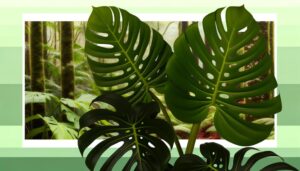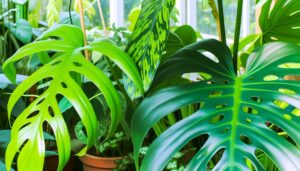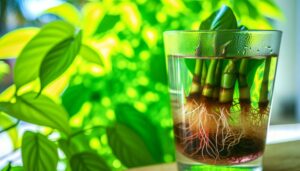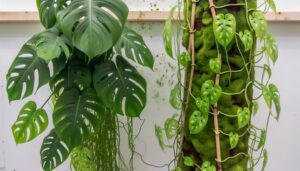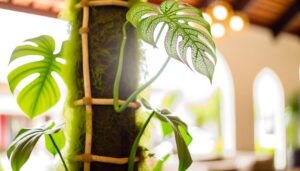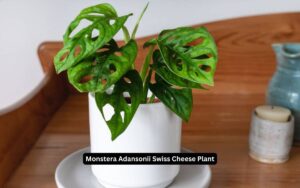Monstera Siltepecana Vs Monstera Adansonii
When comparing Monstera siltepecana and Monstera adansonii, you'll notice distinct differences. M.
siltepecana features elongated, lanceolate leaves with silver veins, primarily found in Mexico and Honduras. Meanwhile, M.
adansonii showcases fenestrated, ovate leaves and a glossy appearance, common from Mexico to Panama. Siltepecana's growth is slower and starts as ground cover, evolving to climbing, whereas Adansonii climbs aggressively and develops prominent aerial roots.
Both prefer indirect light, high humidity, and well-draining soil. They're both susceptible to pests like spider mites and mealybugs.
Dive deeper to explore their unique care requirements and growth distinctions.
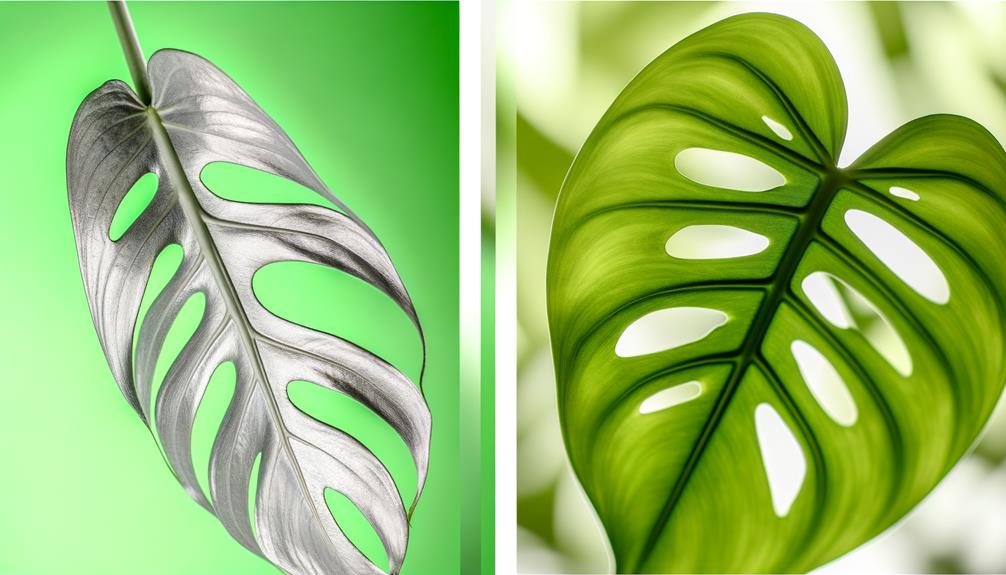
Key Takeaways
- M. siltepecana has silver-veined, lanceolate leaves, while M. adansonii has glossy, fenestrated, ovate leaves.
- M. adansonii climbs more aggressively and employs aerial roots extensively compared to M. siltepecana.
- Siltepecana starts as ground cover with smaller, non-fenestrated leaves before climbing.
- Both species require indirect sunlight, high humidity, and well-draining, organic-rich soil.
- M. siltepecana has a slower growth rate and more compact habit, while M. adansonii grows faster with more perforations.
Origin and Natural Habitat
Monstera siltepecana and Monstera adansonii, both belonging to the Araceae family, originate from the tropical rainforests of Central and South America where they thrive in humid, shaded environments.
You'll find M. siltepecana primarily in Mexico and Honduras, while M. adansonii is widespread from Mexico to Panama. These plants are epiphytes, meaning they grow on other plants for structural support without extracting nutrients from them.
You'll notice they prefer forest understories with dappled light, high humidity, and well-draining soil rich in organic matter. Their natural habitats offer constant warmth and moisture, essential for their growth.
Understanding these conditions helps you replicate their ideal environment, ensuring healthy development and vibrant foliage in your home or greenhouse.
Leaf Shape and Size
When comparing Monstera siltepecana and Monstera adansonii, you'll notice distinct differences in leaf morphology. Monstera siltepecana features elongated, lanceolate leaves with pronounced venation, while Monstera adansonii exhibits fenestrated, ovate leaves with characteristic perforations.
These variations in leaf shape and size highlight their unique growth patterns and size variability within the Monstera genus.
Leaf Morphology Differences
You'll notice that the leaves of Monstera Siltepecana exhibit a more elongated, lanceolate shape, while those of Monstera Adansonii are characterized by their perforations and a more ovate form.
In Monstera Siltepecana, the leaf blade can reach up to 15 cm in length, featuring a smooth surface with pronounced venation, typically showcasing a silvery hue. Conversely, Monstera Adansonii leaves are more rounded, perforated with fenestrations, and possess a glossy texture.
The fenestrations in Monstera Adansonii usually start appearing as the plant matures, providing a distinct, lacy appearance. Both species belong to the Araceae family, yet their morphological leaf differences are striking, aiding in their identification and appreciation within the Monstera genus.
Growth Patterns Compared
Examining the growth patterns of Monstera Siltepecana and Monstera Adansonii, you'll observe that their leaf shape and size offer significant insights into their developmental trajectories and ecological adaptations.
Monstera Siltepecana, belonging to the Araceae family, exhibits elongated, lanceolate leaves with a striking silvery hue and darker venation.
In contrast, Monstera Adansonii, also from the Araceae family, presents ovate leaves with characteristic fenestrations, or holes, that increase with maturity.
Consider these key distinctions:
- Leaf Shape: Monstera Siltepecana features lanceolate leaves, while Monstera Adansonii has ovate leaves.
- Leaf Size: Monstera Siltepecana leaves are generally smaller and narrower than Monstera Adansonii.
- Fenestration: Only Monstera Adansonii develops prominent leaf fenestrations as it matures.
These differences underscore each species' unique evolutionary adaptations.
Size Variability Insights
In exploring the size variability of Monstera Siltepecana and Monstera Adansonii, one notices distinct differences in leaf structure and dimensions that reflect their unique taxonomic characteristics.
Monstera Siltepecana typically exhibits elongated, lanceolate leaves that can reach up to 20 cm in length, with a prominent silver vein pattern.
Meanwhile, Monstera Adansonii, known for its fenestrations, has ovate leaves that vary between 15-45 cm in length, depending on maturity. Adansonii's leaf perforations, or 'windows,' contribute to its distinctive appearance.
Both species belong to the Araceae family, yet their leaf shapes and sizes exemplify their divergent evolutionary adaptations.
Understanding these differences aids in proper identification and care, ensuring ideal growth conditions tailored to each species' needs.
Growth Pattern
Both Monstera siltepecana and Monstera adansonii exhibit distinct growth patterns that are influenced by their ecological niches and genetic variations.
You'll notice that Monstera siltepecana, a hemiepiphyte, initially grows as a ground cover before climbing trees, evolving from small, silver-veined leaves to larger, fenestrated ones.
In contrast, Monstera adansonii, also a hemiepiphyte, develops elongated, perforated leaves early in its life cycle and climbs more aggressively.
Key differences in their growth patterns include:
- Juvenile Morphology: Monstera siltepecana has smaller, non-fenestrated leaves initially.
- Climbing Mechanism: Monstera adansonii employs aerial roots more extensively.
- Leaf Evolution: Monstera siltepecana's leaves transform from silver-veined to fenestrated as it matures.
Care Requirements
When caring for Monstera siltepecana and Monstera adansonii, you'll need to take into account their light and water needs, as well as soil and fertilizer requirements.
Make sure both species receive indirect sunlight to replicate their natural understory habitat, and keep their soil consistently moist but not waterlogged.
Use a well-draining potting mix supplemented with organic matter and apply a balanced, water-soluble fertilizer monthly during the growing season.
Light and Water Needs
Although Monstera Siltepecana and Monstera Adansonii belong to the same genus, they've distinct light and water requirements that you'll need to understand for best growth.
Monstera Siltepecana (M. siltepecana) thrives in moderate to bright indirect light, while Monstera Adansonii (M. adansonii) prefers bright, filtered light but can tolerate lower light conditions.
Both species necessitate a careful balance in watering, avoiding water-logged conditions.
- Light Requirements:
- *M. siltepecana*: Moderate to bright indirect light.
- *M. adansonii*: Bright, filtered light, tolerates lower light.
- Watering Needs:
- *M. siltepecana*: Keep soil evenly moist, but not soggy.
- *M. adansonii*: Allow top inch of soil to dry between waterings.
- Humidity:
- Both species benefit from high humidity, mimicking their native tropical environments.
Soil and Fertilizer
Understanding the light and water needs sets the stage for enhancing the soil and fertilizer requirements for Monstera Siltepecana and Monstera Adansonii.
For both Monstera species, well-draining soil rich in organic matter is paramount. Use a mix containing perlite, peat moss, and orchid bark to promote adequate aeration and moisture retention.
Fertilize Monstera Siltepecana and Monstera Adansonii during their growing season, typically spring through early fall. Employ a balanced, water-soluble fertilizer with an NPK ratio of 20-20-20, diluted to half strength. Over-fertilization can cause root burn, so apply every 4-6 weeks.
Monitor soil pH, keeping it between 5.5 and 7.0 to ensure best nutrient uptake. Proper soil and fertilizer management promotes robust growth and vibrant foliage.
Common Pests and Diseases
Both Monstera Siltepecana and Monstera Adansonii are susceptible to common pests like spider mites (Tetranychidae) and mealybugs (Pseudococcidae), as well as diseases such as root rot caused by overwatering. You need to monitor your plants closely to detect and manage these issues promptly.
Here's a detailed breakdown:
- Spider Mites (Tetranychidae): These arachnids create webbing on leaves, leading to chlorotic spots. Regularly inspect the undersides of leaves.
- Mealybugs (Pseudococcidae): These insects form cotton-like masses on stems and leaves, secreting honeydew that promotes sooty mold.
- Root Rot: Fungal pathogens thrive in overly moist soil, causing roots to turn black and mushy, ultimately leading to plant decline.
Ideal Indoor Conditions
Maintaining ideal indoor conditions for Monstera Siltepecana and Monstera Adansonii involves providing appropriate light, humidity, and temperature to guarantee their healthy growth and minimize stress that could exacerbate pest and disease issues. Aim for bright, indirect light, as direct sunlight may scorch their foliage.
A relative humidity of 60-80% mimics their native tropical environments and prevents desiccation. Both species thrive in temperatures between 65-80°F (18-27°C). Ensure well-draining, aerated soil rich in organic matter, and water when the top inch of soil feels dry. Avoid overwatering to prevent root rot (Pythium spp).
Periodic misting and using a humidity tray can help maintain moisture levels. By tailoring these conditions, you'll promote the best physiological functions and vibrant growth.
Conclusion
To sum up, while both Monstera siltepecana and Monstera adansonii bring unique appeal to your indoor garden, they each have distinct requirements and traits.
Monstera siltepecana's smaller, lance-shaped leaves and climbing habit differ from Monstera adansonii's holey, fenestrated foliage.
Both varieties, needing adequate attention and watchfulness against pests, prosper in moist, shaded light settings.
Bear in mind, “a stitch in time saves nine,” so addressing their specific needs early ensures these lovely aroids thrive in your residence.

